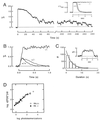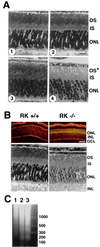Abnormal photoresponses and light-induced apoptosis in rods lacking rhodopsin kinase
- PMID: 10097103
- PMCID: PMC22360
- DOI: 10.1073/pnas.96.7.3718
Abnormal photoresponses and light-induced apoptosis in rods lacking rhodopsin kinase
Abstract
Phosphorylation is thought to be an essential first step in the prompt deactivation of photoexcited rhodopsin. In vitro, the phosphorylation can be catalyzed either by rhodopsin kinase (RK) or by protein kinase C (PKC). To investigate the specific role of RK, we inactivated both alleles of the RK gene in mice. This eliminated the light-dependent phosphorylation of rhodopsin and caused the single-photon response to become larger and longer lasting than normal. These results demonstrate that RK is required for normal rhodopsin deactivation. When the photon responses of RK-/- rods did finally turn off, they did so abruptly and stochastically, revealing a first-order backup mechanism for rhodopsin deactivation. The rod outer segments of RK-/- mice raised in 12-hr cyclic illumination were 50% shorter than those of normal (RK+/+) rods or rods from RK-/- mice raised in constant darkness. One day of constant light caused the rods in the RK-/- mouse retina to undergo apoptotic degeneration. Mice lacking RK provide a valuable model for the study of Oguchi disease, a human RK deficiency that causes congenital stationary night blindness.
Figures




References
Publication types
MeSH terms
Substances
Associated data
- Actions
Grants and funding
LinkOut - more resources
Full Text Sources
Molecular Biology Databases

